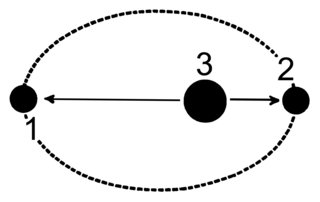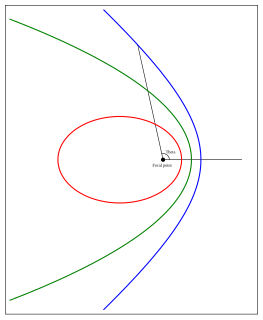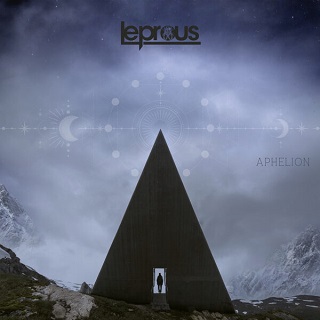An aphelion is the farthest point of an orbit around the Sun.
Contents
Aphelion may also refer to:
An aphelion is the farthest point of an orbit around the Sun.
Aphelion may also refer to:

An apsis is the farthest or nearest point in the orbit of a planetary body about its primary body. The apsides of Earth's orbit of the Sun are two: the aphelion, where Earth is farthest from the sun, and the perihelion, where it is nearest. "Apsides" can also refer to the distance of the extreme range of an object orbiting a host body.

In gravitationally bound systems, the orbital speed of an astronomical body or object is the speed at which it orbits around either the barycenter or, if one body is much more massive than the other bodies of the system combined, its speed relative to the center of mass of the most massive body.

The Hilda asteroids are a dynamical group of more than 5,000 asteroids located beyond the asteroid belt but within Jupiter's orbit, in a 3:2 orbital resonance with Jupiter. The namesake is the asteroid 153 Hilda.

The Aten asteroids are a dynamical group of asteroids whose orbits bring them into proximity with Earth. By definition, Atens are Earth-crossing asteroids (a < 1.0 AU and Q > 0.983 AU). The group is named after 2062 Aten, the first of its kind, discovered on 7 January 1976 by American astronomer Eleanor Helin at Palomar Observatory. As of 2020, 1841 Atens have been discovered, of which 13 are named. Many Atens are classified as potentially hazardous asteroids.

The Amor asteroids are a group of near-Earth asteroids named after the archetype object 1221 Amor. The orbital perihelion of these objects is close to, but greater than, the orbital aphelion of Earth, with most Amors crossing the orbit of Mars. The Amor asteroid 433 Eros was the first asteroid to be orbited and landed upon by a robotic space probe.

(33342) 1998 WT24 is a bright, sub-kilometer asteroid, classified as near-Earth object and potentially hazardous asteroid (PHA) of the Aten group, located in Venus's zone of influence that has frequent close encounters with Mercury, Venus, and Earth. It made a close approach to Earth on 11 December 2015, passing at a distance of about 4.2 million kilometers (2.6 million miles, 11 lunar distances) and reaching about apparent magnitude 11.

In astrodynamics, the orbital eccentricity of an astronomical object is a dimensionless parameter that determines the amount by which its orbit around another body deviates from a perfect circle. A value of 0 is a circular orbit, values between 0 and 1 form an elliptic orbit, 1 is a parabolic escape orbit, and greater than 1 is a hyperbola. The term derives its name from the parameters of conic sections, as every Kepler orbit is a conic section. It is normally used for the isolated two-body problem, but extensions exist for objects following a rosette orbit through the Galaxy.
Aphelia may refer to:
39P/Oterma is a currently inactive periodic comet in the Solar System with an orbital period of nearly 20 years. The size of its nucleus is not known.
C/1992 J1 (Spacewatch) is a comet that was discovered 1 May 1992 by David Rabinowitz of the Spacewatch Project. This was the first comet to be discovered using an automated system.
C/1999 F1 (Catalina) is one of the longest known long-period comets. It was discovered on March 23, 1999, by the Catalina Sky Survey. The current perihelion point is outside of the inner Solar System which helps reduce planetary perturbations to this outer Oort cloud object.
2005 VX3 is trans-Neptunian object and retrograde damocloid on a highly eccentric, cometary-like orbit. It was first observed on 1 November 2005, by astronomers with the Mount Lemmon Survey at the Mount Lemmon Observatory in Arizona, United States. The unusual object measures approximately 7 kilometers (4 miles) in diameter. It has the 3rd largest known heliocentric semi-major axis and aphelion. Additionally its perihelion lies within the orbit of Jupiter, which means it also has the largest orbital eccentricity of any known minor planet.

2012 VP113, also known by its nickname "Biden", is a trans-Neptunian object of the sednoid population, located in the outermost reaches of the Solar System. It was first observed on 5 November 2012 by American astronomers Scott Sheppard and Chad Trujillo at the Cerro Tololo Inter-American Observatory in Chile. The discovery was announced on 26 March 2014. The object probably measures somewhere between 300 and 1000 km in diameter, possibly large enough to be a dwarf planet.

Mars has an orbit with a semimajor axis of 1.524 astronomical units, and an eccentricity of 0.0934. The planet orbits the Sun in 687 days and travels 9.55 AU in doing so, making the average orbital speed 24 km/s.
C/2012 S4 (PanSTARRS) is a non-periodic comet with the largest listed aphelion of any object on the JPL Small-Body Database. But the listed aphelion distance of 500,000 AU (8 ly) from the Sun is a generic near-perihelion unperturbed two-body solution that assumes the Sun and comet are the only two objects in the Universe. Other comets, such as C/2004 R4 (ASAS), C/2015 TQ209 (LINEAR) and C/2017 A3 (Elenin) have meaningless epoch-dependent solutions with aphelia of more than 1,000,000 AU (16 ly). As a comparison, the closest star, Proxima Centauri, is about 4.24 light years from the Sun, and Wolf 359 is 7.78 light years away. Any comet more than about 150,000 AU (2 ly) from the Sun can be considered lost to the interstellar medium. Using an epoch when C/2012 S4 (PanSTARRS) is beyond the planetary region of the Solar System, it is clear C/2012 S4 (PanSTARRS) will not be ejected from the Solar System.
C/2015 ER61 (PanSTARRS) is a comet, inner Oort cloud object. When classified as a minor planet, it had the fourth-largest aphelion of any known minor planet in the Solar System, after 2005 VX3, 2012 DR30, and 2013 BL76. It additionally had the most eccentric orbit of any known minor planet, with its distance from the Sun varying by about 99.9% during the course of its orbit, followed by 2005 VX3 with an eccentricity of 0.9973. On 30 January 2016, it was classified as a comet when it was 5.7 AU from the Sun. It comes close to Jupiter, and a close approach in the past threw it on the distant orbit it is on now.

The Aphelion Imaging Software Suite is a software suite that includes three base products - Aphelion Lab, Aphelion Dev, and Aphelion SDK for addressing image processing and image analysis applications. The suite also includes a set of extension programs to implement specific vertical applications that benefit from imaging techniques.

2014 FE72 is a trans-Neptunian object first observed on 26 March 2014, at Cerro Tololo Inter-American Observatory in La Serena, Chile. It is a possible dwarf planet, a member of the scattered disc, whose orbit extends into the inner Oort cloud. Discovered by Scott Sheppard and Chad Trujillo, the object's existence was revealed on 29 August 2016. Both the orbital period and aphelion distance of this object are well constrained. 2014 FE72 had the largest barycentric aphelion until 2018. However, the heliocentric aphelion of 2014 FE72 is second among trans-Neptunian objects (after the damocloid 2017 MB7).

Aphelion is the seventh studio album by Norwegian progressive rock band Leprous, released on 27 August 2021 via Inside Out Music. The album was first hinted by the single "Castaway Angels" in December 2020, and six months later, the band announced the album and began releasing two promotional singles prior to the album's release; "Running Low" and "The Silent Revelation", plus a music video for "Nighttime Disguise". It was recorded in several recording studios in Scandinavia. A cellist and violinist were recruited for the production. Most of the songs were written and composed by Leprous vocalist Einar Solberg.